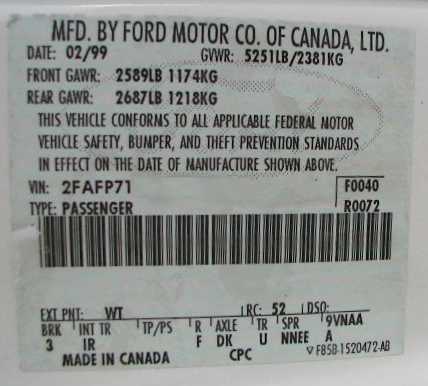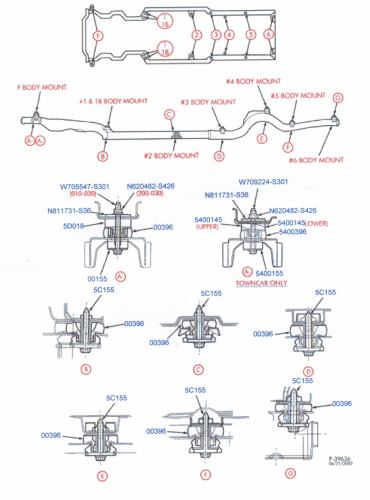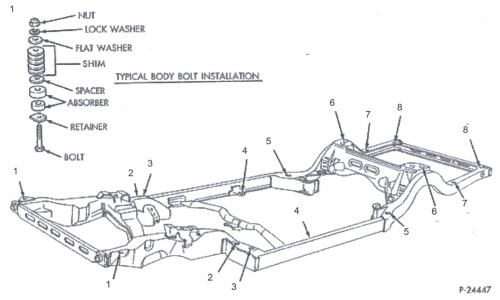| Part Number |
From |
To |
Description |
Suggested Retail (April 2006) |
| F8AZ-5560-EA |
1998 |
Early 1999 |
"EE" springs that came
in 98' P71's. First year for this revision of the "EE" springs, also
the first year of the new body style with the new redesigned watts
linkage rear suspension. They ride low especially under load and may
be useful as "lowering springs". Catchword "EPS". |
"Obsolete" |
| F8AZ-5560-GA |
Early 1999 |
Mid 2001 |
After many complaints from police departments
about low ride height in the rear, ford changed to "GG" springs in
mid-1999. Catchword "GNX" |
Superceded by 3W7Z-5560-EA |
| F8AZ-5560-HA |
Mid 2001 |
2002 |
The "HH" springs ride a little higher than the
"GG" springs. Catchword "HAP" |
Superceded by 3W7Z-5560-FA |
| 3W7Z-5560-EA | 2003 |
2005 |
GNX |
Superceded by 6W7Z-5560-A |
| 3W7Z-5560-FA | 2003 |
2005 |
HAP |
Superceded by 6W7Z-5560-B |
| 6W7Z-5560-A |
2006 |
These are the springs that are
factory installed in 2006 and later crown victorias during production.
They are also what you will recieve if you attempt to order rear spring
service assemblies for a 1998-2005 police interceptor too. |
$37.16 |
|
| 6W7Z-5560-B |
2006 |
PBA These are the springs that are factory installed in 2006 and later crown victorias during production. They are also what you will recieve if you attempt to order rear spring service assemblies for a 1998-2005 police interceptor too. |
$38.79 |
|
| F8AZ-5560-FA |
1998 |
Mid 2001 |
Compressed Natural Gas
(CNG) "FF" Springs. CNG fuel tanks are located in the rear of
the car and weigh a couple hundred pounds, yet the car still has
to ride the same height as gasoline cars do. Catchword "FTP". |
$32.37 (Limited availability. Soon to be obsolete) |
| D9AZ-5560-AE |
1993 |
1997 |
"EE" springs used in 1993 to 1997 police
cruisers. Also, if sagging is observed in the rear of 98+ CNG crown victorias, the solution is to remove the factory installed "FTP" or "HAP" springs and install a set of the these. See also: TSB 02-18-6. Catchword "TOW" |
$82.45 |
| D9AC-5560-ADA |
1992 |
Engineering code for the rear
springs used in the later "box bodies" and very early "aero-body"
police cruisers up until the 1992 model year. Catchword "SPA" |
"Obsolete" |
|
| F6AZ-5560-DA |
1996 |
1997 |
Compressed Natural Gas
(CNG) "DD" springs installed by ford in 1996 and 1997 vehicles.
Catchword "DSJ". |
"Obsolete" |
| D9AZ-5536-A |
1979 |
2003 |
Spring insulator that sits between the top of
the spring and the body of the car. If your car is older and the rubber
is cracked or if you are converting from air springs to conventional
steel coil springs, you will need two of these. |
$8.57 |
| F1VY-5664-A |
1992 |
2003 |
Rear swaybar endlink |
$11.02 |

| Part Number |
From |
To |
Description |
Suggested Retail |
| D9AC-5310-AMA |
1992 |
Engineering code for the front
springs used in the later "box bodies"
and very early "aero-body" police cruisers up until the 1992 model
year. Catchword "MIM" |
"Obsolete" |
|
| D9AZ-5310-AN |
1993 |
2002 |
Factory installed front coil spring on 1993-2002
police cruisers. Will physically fit in 1979-1992 crown vics too.
Catchword "NUL" |
Superceded by D9AZ-5310-W |
| D9AZ-5310-W |
$166.40 |
|||
| 3W7Z-5310-AA |
2003 |
2005 |
Factory installed front coil spring in 2003-2005
police cruisers. Will NOT physically fit/work in a 1979-2002 crown vic. |
$74.60 |
| C9AZ-5415-B |
1979 |
2002 |
Front Spring Insulator |
$19.82 |
| 5W1Z-5415-AA |
2003 |
2003 |
Front Spring Insulator (Supercedes 3W1Z-5415-AA) |
$46.80 |
| F4AZ-5K484-A |
1992 |
1994 |
Front Swaybar Endlink |
$66.30 |
| F6AZ-5K484-AA |
1995 |
1997 |
Front Swaybar Endlink |
$56.92 |
| F8AZ-5K484-AA |
1998 |
2002 |
Front Swaybar Endlink |
$54.23 |
| 3W1Z-5K484-AA |
2003 |
2003 |
Front Swaybar Endlink |
$36.10 |

